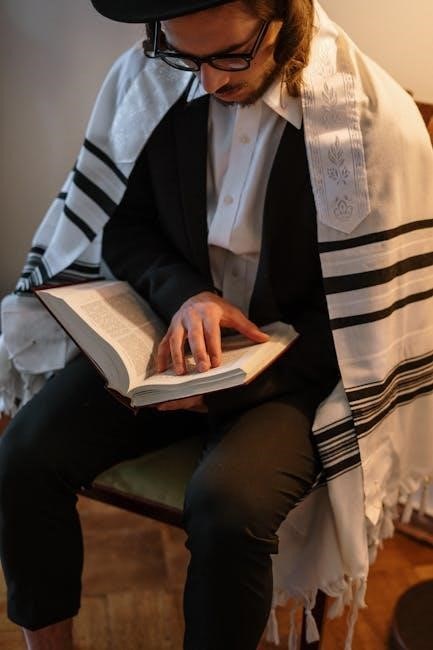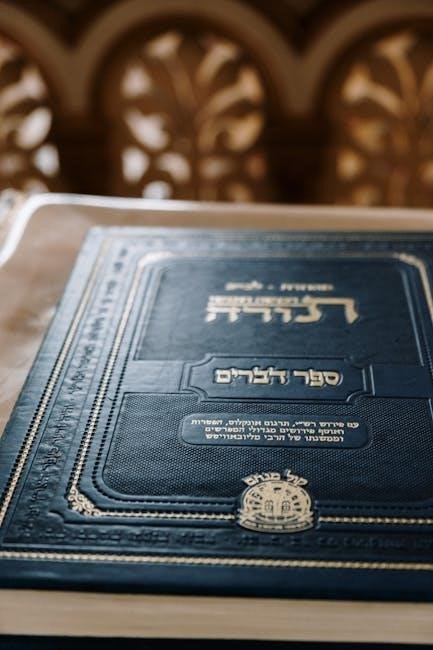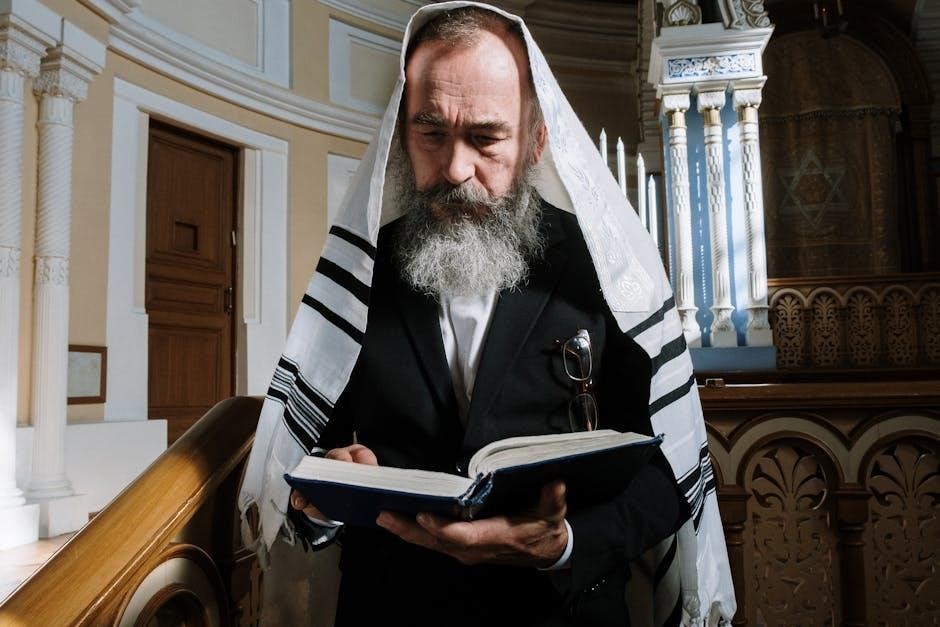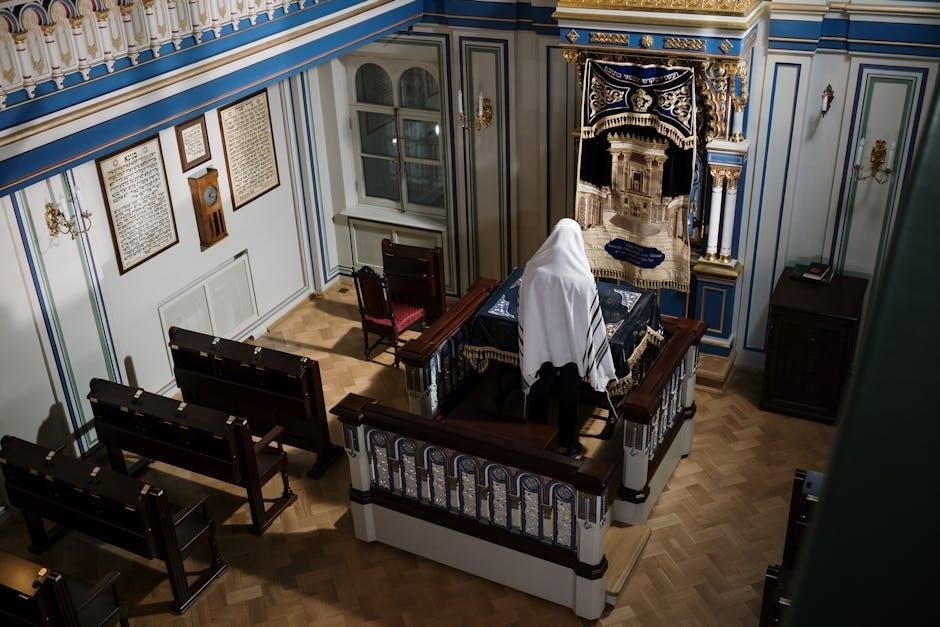
Amidah Prayer in Hebrew PDF: A Comprehensive Guide
Embark on a spiritual journey with our comprehensive guide to the Amidah prayer. Explore its rich history, significance, and structure. Access resources, including PDF downloads, to deepen your understanding. Learn about kavanah, intention, and variations in the Amidah text.
The Amidah, also known as the Shemoneh Esrei, meaning “the Eighteen,” is a central prayer in Jewish worship. Despite its name, it contains nineteen blessings on weekdays. Recited while standing, facing Jerusalem, it’s a cornerstone of daily Jewish prayer services. Its origins trace back to the Great Assembly around 450 BCE, during the Second Temple period. Ezra and Nehemiah were among those who played a crucial role in its composition.

The Amidah serves as a profound dialogue between the individual and God. It encompasses praises, requests, and thanksgiving. It is recited silently by individuals and repeated aloud by the prayer leader (chazzan). The pursuit of proper kavanah, or directed attention, is essential. It is a prayer that connects generations, invoking the memory of the Patriarchs. The Amidah’s structure and content reflect the core tenets of Jewish faith and values. Its enduring presence in Jewish liturgy speaks to its timeless significance and spiritual depth.
The Significance of the Amidah in Jewish Prayer
The Amidah holds unparalleled significance within Jewish prayer. It is considered the central prayer, a focal point of connection with the Divine. Recited in every service, it provides a structured framework for expressing praise, gratitude, and supplication. Unlike other prayers, the Amidah is said while standing, symbolizing reverence and readiness before God. It is a prayer of both communal and personal importance. Individuals recite it silently, fostering introspection and direct communication with God. The repetition by the chazzan allows the community to participate collectively, uniting their voices in prayer.
The Amidah’s structure reflects core Jewish values and beliefs. It touches upon themes of God’s greatness, redemption, healing, and the hope for a restored world. Its regular recitation reinforces these principles, shaping the individual’s worldview and strengthening their faith. The Amidah serves as a bridge connecting Jews across time and geography. Its consistent presence in Jewish liturgy ensures continuity and a shared spiritual experience, regardless of location or background. It is a prayer that embodies the essence of Jewish faith and tradition.
The Structure of the Amidah Prayer
The Amidah, also known as the Shemoneh Esrei, is structured around a series of blessings, each with a specific theme. On weekdays, it consists of nineteen blessings, while on Shabbat and holidays, it is shortened to seven. The initial three blessings, known as the Avot, Gevurot, and Kedushat Hashem, focus on praising God. The middle blessings vary depending on the day and occasion, addressing themes such as requests for knowledge, repentance, healing, prosperity, and justice. These blessings reflect the daily needs and aspirations of the Jewish people.
The final three blessings, known as Avodah, Hoda’ah, and Shalom, express gratitude and a desire for peace. This structured approach allows for a comprehensive expression of faith, encompassing praise, petition, and thanksgiving. The Amidah’s consistent structure provides a sense of familiarity and continuity, connecting worshippers across generations. The framework guides individuals through a journey of spiritual reflection and connection with God. It’s a carefully designed structure fostering a meaningful and transformative prayer experience.
Avot: Invoking the Ancestors
The Avot, meaning “fathers,” constitutes the opening blessing of the Amidah, a pivotal moment in Jewish prayer. This section invokes the merits and legacy of the Jewish people’s earliest ancestors: Abraham, Isaac, and Jacob. In some traditions, the matriarchs Sarah, Rebecca, Rachel, and Leah are also included, acknowledging their foundational role.
By mentioning these figures, worshippers connect themselves to the chain of tradition and the covenant established between God and their forefathers. The Avot praises God as the God of Abraham, Isaac, and Jacob, emphasizing the personal relationship between God and these individuals. It acknowledges God’s boundless kindness and creative power, recognizing Him as the source of all existence. This invocation reminds worshippers of their heritage and the enduring faith passed down through generations. The Avot establishes a foundation of ancestral connection and divine praise, setting the tone for the entire Amidah prayer. It acts as a powerful reminder of faith.
Gevurot: God’s Power and Might
Gevurot, the second blessing of the Amidah, shifts the focus to God’s immense power and might. This section acknowledges God as the source of life and the reviver of the dead, highlighting His ability to perform extraordinary acts of salvation and renewal. It proclaims God’s strength and ability to sustain the living, heal the sick, and free the captive, showcasing His compassionate involvement in the world.
The Gevurot praises God as the one who remembers His creatures with mercy, emphasizing His unwavering care and concern for humanity. It acknowledges God’s control over the natural world, recognizing Him as the cause of wind and rain, essential elements for sustenance and growth. This blessing instills a sense of awe and reverence for God’s limitless power and encourages worshippers to recognize His role as the ultimate source of strength, healing, and redemption. It serves as a testament to God’s omnipotence.
Kedushat Hashem: Sanctification of God’s Name
Kedushat Hashem, the third blessing of the Amidah, centers on the sanctification of God’s name. This section proclaims God’s holiness and uniqueness, recognizing Him as the supreme being worthy of all praise and adoration. It echoes the words of the angels, who thrice repeat “Holy, holy, holy is the Lord of hosts; the whole earth is full of His glory,” emphasizing God’s transcendence and immanence.

During the Chazzan’s repetition of the Amidah, the Kedushah is recited, further amplifying the sanctification of God’s name within the community. This section serves as a reminder of the importance of upholding God’s name with reverence and respect in all aspects of life. It encourages worshippers to emulate the angels by constantly proclaiming God’s holiness and striving to live in accordance with His divine will. Kedushat Hashem is the third blessing in Amidah prayer. It highlights the importance of holiness.
Weekday Amidah vs. Shabbat Amidah
The Amidah prayer undergoes significant modifications between weekdays and Shabbat, reflecting the distinct character of each day. The weekday Amidah, also known as the Shemoneh Esrei or Eighteen Blessings, comprises nineteen blessings, addressing various needs and requests. These include supplications for knowledge, repentance, healing, prosperity, and the restoration of Jerusalem.
In contrast, the Shabbat Amidah is significantly shorter, consisting of only seven blessings. The middle blessing, which on weekdays contains a series of petitions, is replaced on Shabbat with a single blessing focusing on the sanctity of the day. This reflects the Shabbat’s emphasis on rest, spiritual reflection, and communal celebration. The Shabbat Amidah focuses on themes related to the day’s holiness. The weekday Amidah contains nineteen blessings for various needs.
The Amidah in Hebrew: Text and Transliteration
The Amidah prayer is traditionally recited in Hebrew, the language of Jewish prayer and scripture. The Hebrew text carries profound spiritual significance, connecting worshippers to centuries of Jewish tradition and the original words of the prayer. For those unfamiliar with Hebrew, transliteration provides a valuable tool for engaging with the Amidah.
Transliteration involves rendering the Hebrew text into a Roman alphabet, allowing individuals to pronounce the words correctly even without understanding the Hebrew language. Resources offering both the Hebrew text and transliteration of the Amidah are widely available, facilitating participation for individuals of all backgrounds. These resources often include translations, enabling worshippers to grasp the meaning and intention behind the words they are reciting.

Kavanah: Intention and Focus in Prayer
Kavanah, the Hebrew term for intention and focus, is a vital element of Jewish prayer, particularly within the Amidah. It refers to the mental and emotional state of being fully present and engaged during prayer, directing one’s heart and mind towards the Divine. Kavanah is not merely about reciting the words correctly but also about understanding their meaning and connecting with their spiritual essence.
Cultivating kavanah involves minimizing distractions, contemplating the significance of the words, and focusing on one’s relationship with God. Jewish tradition emphasizes that prayer without kavanah is like a body without a soul. Various resources, including teachings from Jewish thinkers, offer guidance on developing kavanah in prayer. By striving for kavanah, worshippers can transform the Amidah from a rote recitation into a meaningful encounter with the Divine.
Variations in the Amidah Text
The Amidah prayer, while maintaining a core structure, exhibits variations in its text depending on several factors. These variations reflect the specific occasion, the time of day, and the Jewish tradition followed. For instance, the weekday Amidah differs significantly from the Shabbat Amidah, with the latter omitting requests for personal needs. Special additions are incorporated during festivals and High Holy Days, reflecting the unique themes of these occasions.

Different Jewish communities, such as Ashkenazi, Sephardi, and others, may have slight variations in the wording and order of certain blessings. Some congregations may also include optional additions to promote inclusivity or reflect contemporary concerns. These variations enrich the Amidah, allowing it to resonate with diverse experiences and perspectives while preserving its fundamental essence as a prayer of praise, petition, and thanksgiving.
Resources for Learning the Amidah (Including PDF Downloads)
To facilitate a deeper understanding and engagement with the Amidah prayer, numerous resources are available. These resources cater to diverse learning styles and levels of knowledge, from beginners to advanced students. Many websites offer the full Hebrew text of the Amidah, along with English translations and transliterations, aiding in comprehension and pronunciation.
For those seeking a more structured approach, various books and study guides provide detailed explanations of each blessing, its meaning, and its significance within the broader context of Jewish prayer. Additionally, several organizations and institutions offer online courses and workshops on the Amidah, led by experienced educators. To further enhance accessibility, PDF downloads of the Amidah text, translations, and commentaries are readily available, allowing individuals to study at their own pace and convenience, deepening their connection to this central prayer of Jewish tradition.
The Amidah and its Connection to the Lord’s Prayer
The Amidah, a central prayer in Judaism, and the Lord’s Prayer, a cornerstone of Christian worship, share intriguing connections that highlight the historical and theological interplay between the two faiths. Some scholars propose that the Lord’s Prayer, taught by Jesus, draws inspiration from the Amidah, reflecting the shared Jewish context of early Christianity.
Parallels can be observed in themes such as the sanctification of God’s name, the seeking of God’s kingdom, and the petition for daily sustenance. The Amidah’s emphasis on praising God and requesting divine assistance resonates with the spirit of the Lord’s Prayer. While differences exist, examining these prayers side-by-side reveals a common thread of devotion and a shared desire to connect with the divine. This connection underscores the historical relationship between Judaism and Christianity, shedding light on the development of both traditions.